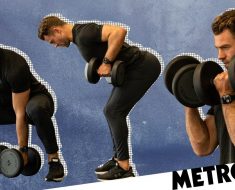“When you are dealing with migraines a third to a half of the days in a month, it’s impossible to maintain any kind of gym routine, or diet,” says Brian Hendriks. That was the situation last year for the 39-year-old software engineer from Pacific Palisades, California. A former center for the London Blitz football team, he’d always been a bigger guy; maybe not in great shape, but strong—he’d put up 405 pounds on the bench.
But when he was 32, he had a bleed in his brain stem; the resulting neurological issues kept him out of the gym. Then he and his wife had a baby; then, in 2015, came the migraines. They were debilitating: “I was feeling pretty helpless, and hopeless about my life,” he says. He went from 195 pounds in 2015 to 235 pounds in 2018.
A new medication helped begin his turnaround. “It absolutely changed my life,” he says; his migraines dropped to twice a month. He decided to focus on his health, and committed to some drastic changes.
He first wanted to drop weight, down to 170 pounds. To do so he turned to juice—four or five servings a day, with a cheat day every two weeks, where he ate a single meal. He admits it wasn’t easy, but he lost 40 pounds in about two and a half months.
From there he moved to intermittent fasting, eating normally for five days and fasting for two. That cut another 25 pounds; in six months he’d hit his goal weight. From there he shifted to six days of normal eating and one of fasting, looking to maintain his weight while building muscle.
He aimed to work out ten times a week. That meant a half hour of cardio on the elliptical in the morning, then hitting the gym for every lunch break. He upped his calorie intake to 1800 a day, with at least 200 grams of protein.

Brian Hendriks
Hendriks stayed motivated by—well, by not giving himself a choice. He prepped his lunches for the week every Sunday, eating the same thing at the same time every day. Going to the gym was also non-negotiable; if he was going to work, he’d be working out during lunch. By creating an ironclad routine, he was that much more likely to follow it. “By removing all the choices,” he says, “I never allowed myself to make a bad choice.”
A year later, the strict regimen has paid off. “People that I haven’t seen in a long time are pretty shocked to see me now,” he says. “Especially people who only knew me during my heavy periods. Not everyone recognizes me.” He’s happier with how he looks, and with being able to fit into clothes that look good. (He’s at 14.9 percent body fat; for his 40th birthday he wants to bring that down to 13 percent.) “But the best side effect of my fitness is the increased energy I have to play with my kids,” he says, “and feeling like I’m a good role model for my children and their health.”
Source: Read Full Article





